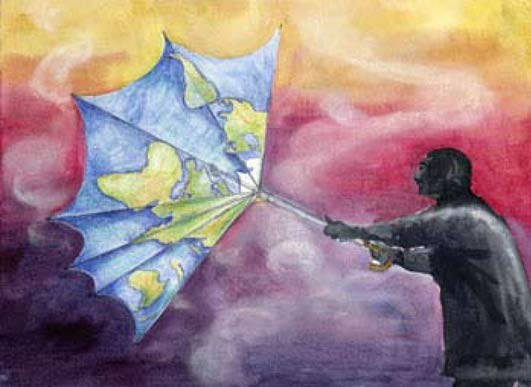 Clear and quiet this early Monday on California’s north coast, with the outside air feeling a bit more on the warmer side than the last few days.
Clear and quiet this early Monday on California’s north coast, with the outside air feeling a bit more on the warmer side than the last few days.
Two big rain storms are expected tomorrow night/maybe early Wednesday, and then again on Friday — big storms, but too little for the any drought assistance. Meteorologist Duane Dykema: “All this helps, especially in the short term. In terms of water supply, it doesn’t make a big difference…This should be the type of wet windy storm that’s typical for this time of the year — except that we haven’t had any.”
(Illustration found here).
Hence, the drought. Despite the rains a-coming, and the storms we had a week or two ago, the dry conditions persist, and will apparently be around awhile, a long-like while. Even natural ecosystems are feeling the heat, even up here in the northern part of the state where there’s a shitload of rivers, streams and lakes, the water is getting pinched-off. Via the Lost Coast Outpost this past weekend and the USGS WaterWatch indicators for this area:
Hovering over each dot shows a compilation of data.
The one bright red dot is Bull Creek near Weott.
Today’s readings show that the water flows are only at 7 percent of the average for this time of year.
The Eel River at Scotia is only at 23 percent of average for this time of year.
The Mad River near Arcata is at 37 percent of average flow.
The mouth of the Mad River is just down the street from me — our local drinking water is pulled in part from there.
Water is the precious. We can’t live without water and if we want to live anywhere in the US, the weather-related aspect has to be factored in and become part of a country’s iternerary. And why is some parts of America doing good, and other parts suck, and does misery play a part?
Whether somewhere is an attractive place to live depends more on being happy, or maybe less miserable.
And the state of misery in the US might be located where you’re located — the sixth annual Gallup-Healthways Well-Being Index reflects the ups and downs of being alive nowadays. The most-miserable state in the union? West Virginia.
In fact, the three most-miserable states stayed the same last year from 2012 — Mississippi, Kentucky, and, West Virginia.
My state, California, moved up a notch, from 17th miserable to 18th.
And the sub-text to West Virginia (via USAToday):
No Americans had as negative an outlook about their future as West Virginians, who rated their projected life in five years the lowest.
Additionally, just 44.8 percent of residents described themselves as thriving, the lowest in the nation.
West Virginia also had the lowest score for overall emotional health, ranking either the lowest or second-lowest in nearly all of the indicators considered by the Gallup-Healthways Well-Being Index.
Unsurprisingly, residents had less confidence about the future of the U.S. economy than those anywhere else in the nation.
Outside of attitudes, West Virginians were also the least physically healthy respondents in the nation.
The state had the highest rates of both high blood pressure and high cholesterol, and the second highest obesity rate.
It also had the highest rate of respondents unable to partake in age-appropriate activities.
Ouch! Hard to fathom as the data could have come from a third-world country, not the good-old US of A.
One interesting point to the index is high income — once at a certain level, going beyond is apparently just McScrooge.
Dan Dan Witters, research director of the Index:
“For the most part, well-being goes up with income,” according to Witters.
While a low income can definitely impair well-being, as incomes rise, factors such as emotional health tend to level out, Witters explained.
For individuals, “emotional health scores kind of hit their peak at about $75,000 a year.
“And after that point, they really don’t get any better.”
Surprisingly, young Wall Street assholes are feeling the misery overload — they’re well about the Index cut-off, so they might as well just kill themselves.
Via Quartz:
Over a few beers after work one spring evening, two junior Goldman Sachs employees started contemplating the best ways to kill themselves.
“If the goal is, like, how do I inflict maximum psychological damage, then I think just going up to your desk and blowing your brains out in the middle of the day would be the best,” said Jeremy Miller-Reed, 23.
“Nah,” said Samson White, 22. “You know what would happen? All the other analysts would get an e-mail from the associates saying, ‘Can you guys clean this up?’ And then everyone would go back to work.”
Misery is limitless.
(Illustration out front found here).